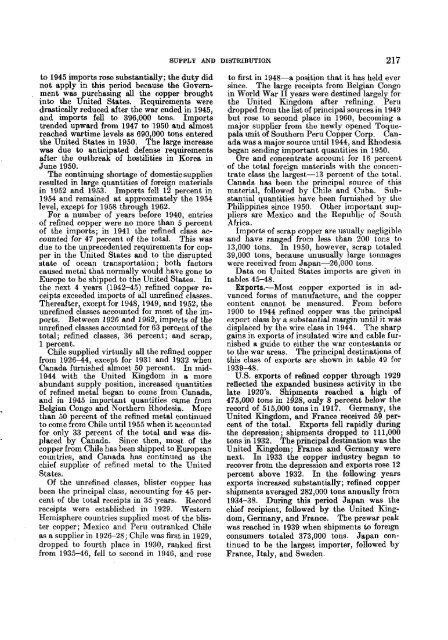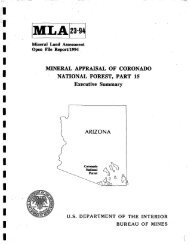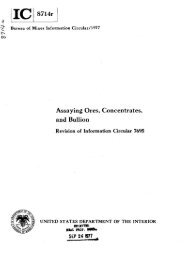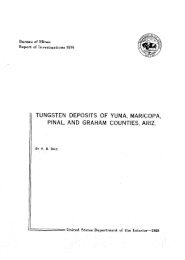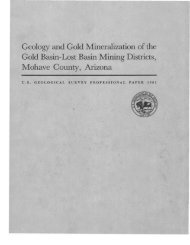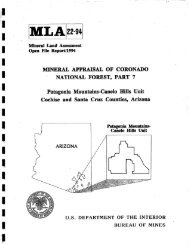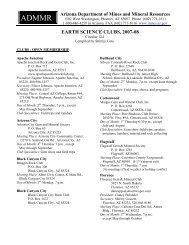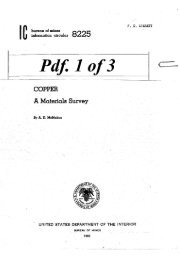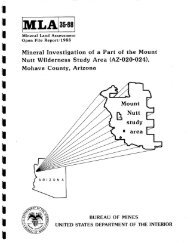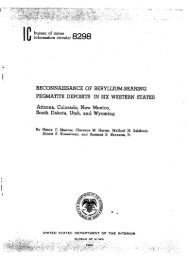IC 8225 - State of Arizona Department of Mines and Mineral ...
IC 8225 - State of Arizona Department of Mines and Mineral ...
IC 8225 - State of Arizona Department of Mines and Mineral ...
You also want an ePaper? Increase the reach of your titles
YUMPU automatically turns print PDFs into web optimized ePapers that Google loves.
SUPPLY AND DISTRIBUTION 217to 1945 imports rose substantially; the duty didnot apply in this period because the Governmentwas purchasing all the wpper broughtinto the United <strong>State</strong>s. Requirements weredrastically reduced after the war ended in 1945,<strong>and</strong> imports fell to 396,000 tons. Im ortstrended upward from 1947 to 1950 <strong>and</strong> a ? mostreached wartime levels as 690,000 tons enteredthe United <strong>State</strong>s in 1950. The large increasewas due to anticipated defense requirementsafter the outbreak <strong>of</strong> hostilities in Korea inJune 1950.The continuing shortage <strong>of</strong> domesticsuppliesresulted in large quantities <strong>of</strong> foreign materialsin 1952 <strong>and</strong> 1953. Imports fell 12 percent in1954 <strong>and</strong> remained at approximately the 1954level, except for 1958 through 1962.For a number <strong>of</strong> years before 1940, entriea<strong>of</strong> refined copper were no more than 5 percent<strong>of</strong> the imports; in 1941 the refined class accountedfor 47 percent <strong>of</strong> the total. This wasdue to the unprecedented requirements for copperin the United <strong>State</strong>s <strong>and</strong> to the disruptedstate <strong>of</strong> ocean transportation; both factorscaused metal that normally would have gone toEurope to be shipped to t'he United <strong>State</strong>s. Inthe next 4 years (194245) refined copper receiptsexceeded imports <strong>of</strong> all unrefined classes.Thereafter, except for 1948,1949, <strong>and</strong> 1952, theunrefined classes accounted for most <strong>of</strong> the imports.Between 1926 <strong>and</strong> 1962, imports <strong>of</strong> theunrefined classes accounted for 63 percent <strong>of</strong> thetotal; refined classes, 36 percent; <strong>and</strong> scrap,1 percent.Chile supplied virtually all the refined copperfrom 192644, exce t for 1931 <strong>and</strong> 1932 whenCanada furnished a P most 50 percent. In mid-1944 with the United Kingdom in a moreabundant suppl position, increased quantities<strong>of</strong> refined meta 9 began to come from Canada,<strong>and</strong> in 1945 important quantities came fromBelgian Congo <strong>and</strong> Northern Rhodesia. Morethan 50 percent <strong>of</strong> the refined metal continuedto come from Chile until 1955 when it accountedfor only 33 percent <strong>of</strong> the total <strong>and</strong> was displacedby Canada. Since then, most <strong>of</strong> thecopper from Chile has been shipped to Europeancountries, <strong>and</strong> Oanada has continued as thechief supplier <strong>of</strong> refined metal to the United<strong>State</strong>s.Of the unrefined classes, blister copper hasbeen the principal class, accounting for 45 percent<strong>of</strong> the total receipts in 35 years. Recordreceipts were established in 1929. WesternHemisphere countries supplied most <strong>of</strong> the blistercopper; Mexico <strong>and</strong> Peru outranked Chileas a supplier in 1926-28; Chile was first in 1929,dropped to fourth place in 1930, ranked firstfrom 193546, fell to second in 1946, <strong>and</strong> roseto iirst in 1948-a position that it has held eversince. The large receipts from Be1 'an Congoin World War I1 years were destine&argely forthe United Kingdom after refining. Perudropped from the list <strong>of</strong> principal sources in 1949but rose to second place in 1960, becoming amajor supplier from the newly opened Toquepalallnit <strong>of</strong> Southern Peru Copper Corp. Canadawas a major source until 1944, <strong>and</strong> Rhodesiabegan sending important quantit'ies in 1950.Ore <strong>and</strong> concentrate account for 16 percent<strong>of</strong> the total foreign materials with the concentrateclass the largest-13 percent <strong>of</strong> the total.Canada has been the principal source <strong>of</strong> thismaterial, followed by Chile <strong>and</strong> Cuba. Substantialquantities have been furnished by thePhilippines since 1950. Other important suppliersare Mexico <strong>and</strong> the Republic <strong>of</strong> SouthAfrica.Imports <strong>of</strong> scrap copper are usually negligible<strong>and</strong> have ranged from less than 200 tons to13,000 tons. In 1950, however, scrap totaled39,000 tons, because unusually largo tonnageswere received from Japan-26,000 tons.Data on United <strong>State</strong>s imports are given intables 4548.Exports.-Most copper exported is in advancedforms <strong>of</strong> manufacture, <strong>and</strong> the coppercontent cannot be measured. From before1900 to 1944 refined copper was the principalexport class by a substantial margin until it wasdisplaced by the wire class in 1944. The sharpgains in exports <strong>of</strong> insulated wire <strong>and</strong> cable furnisheda guide to either the war contestants orto the war areas. The principal destinations <strong>of</strong>this class <strong>of</strong> exports are shown in table 49 for193948.US. exports <strong>of</strong> refined copper through 1929reflected the exp<strong>and</strong>ed business activit in tbelate 1920's. Shipments reached a zigh <strong>of</strong>475,000 tons in 1928, only 8 percent below therecord <strong>of</strong> 515,000 tons in 1917. Germany, theUnited Kingdom, <strong>and</strong> France received 59 percent<strong>of</strong> the total. Exports fell ra idly duringthe depression; shipments droppe cf' to 111,000tons in 1932. The principal destmation was theUnited Kingdom; France <strong>and</strong> Germany werenext. In 1933 the copper industv began torecover from the depression <strong>and</strong> exports rose 12percent above 1932. In the following yearsexports increased substantially; refined coppershipments averaged 282,000 tons annually from1934-38. During this period Japan was thechief recipient, followed by the United Kingdom,Germany, <strong>and</strong> France. The prewar peakwas reached in 1939 when shipments to foreignconsumen totaled 373,000 tons. Japan continuedto be the largest importer, followed byFrance, Italy, <strong>and</strong> Sweden.


